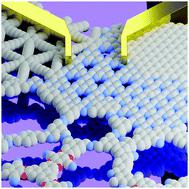当前位置:
X-MOL 学术
›
Chem. Soc. Rev.
›
论文详情
Our official English website, www.x-mol.net, welcomes your feedback! (Note: you will need to create a separate account there.)
Development of metal-free layered semiconductors for 2D organic field-effect transistors
Chemical Society Reviews ( IF 46.2 ) Pub Date : 2021-08-26 , DOI: 10.1039/d1cs00497b David Burmeister 1, 2 , Matthias G Trunk 1, 2 , Michael J Bojdys 1, 2, 3
Chemical Society Reviews ( IF 46.2 ) Pub Date : 2021-08-26 , DOI: 10.1039/d1cs00497b David Burmeister 1, 2 , Matthias G Trunk 1, 2 , Michael J Bojdys 1, 2, 3
Affiliation

|
To this day, the active components of integrated circuits consist mostly of (semi-)metals. Concerns for raw material supply and pricing aside, the overreliance on (semi-)metals in electronics limits our abilities (i) to tune the properties and composition of the active components, (ii) to freely process their physical dimensions, and (iii) to expand their deployment to applications that require optical transparency, mechanical flexibility, and permeability. 2D organic semiconductors match these criteria more closely. In this review, we discuss a number of 2D organic materials that can facilitate charge transport across and in-between their π-conjugated layers as well as the challenges that arise from modulation and processing of organic polymer semiconductors in electronic devices such as organic field-effect transistors.
中文翻译:

用于二维有机场效应晶体管的无金属层状半导体的开发
迄今为止,集成电路的有源元件主要由(半)金属组成。除了对原材料供应和定价的担忧之外,电子产品中对(半)金属的过度依赖限制了我们的能力(i)调整活性成分的性能和成分,(ii)自由处理其物理尺寸,以及(iii)将其部署扩展到需要光学透明度、机械灵活性和渗透性的应用。二维有机半导体更符合这些标准。在这篇综述中,我们讨论了许多可以促进电荷在 π 共轭层之间传输的 2D 有机材料,以及有机聚合物半导体在电子器件(例如有机领域)中的调制和加工所带来的挑战。效应晶体管。
更新日期:2021-08-26
中文翻译:

用于二维有机场效应晶体管的无金属层状半导体的开发
迄今为止,集成电路的有源元件主要由(半)金属组成。除了对原材料供应和定价的担忧之外,电子产品中对(半)金属的过度依赖限制了我们的能力(i)调整活性成分的性能和成分,(ii)自由处理其物理尺寸,以及(iii)将其部署扩展到需要光学透明度、机械灵活性和渗透性的应用。二维有机半导体更符合这些标准。在这篇综述中,我们讨论了许多可以促进电荷在 π 共轭层之间传输的 2D 有机材料,以及有机聚合物半导体在电子器件(例如有机领域)中的调制和加工所带来的挑战。效应晶体管。



























 京公网安备 11010802027423号
京公网安备 11010802027423号